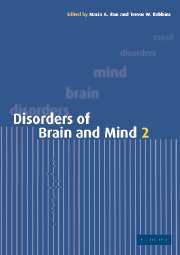Book contents
- Frontmatter
- Contents
- List of contributors
- Preface
- Part I Genes and behaviour
- Part II Brain development
- Part III New ways of imaging the brain
- Part VI Imaging the normal and abnormal mind
- Part V Consciousness and will
- Part IV Recent advances in dementia
- Part VII Affective illness
- 14 The neuropathology of mood disorders
- 15 The neural substrates of anxiety
- 16 Social separation models of depression
- Part VIII Aggression
- Part IX Drug use and abuse
- Index
- Plate section
- References
14 - The neuropathology of mood disorders
from Part VII - Affective illness
Published online by Cambridge University Press: 19 January 2010
- Frontmatter
- Contents
- List of contributors
- Preface
- Part I Genes and behaviour
- Part II Brain development
- Part III New ways of imaging the brain
- Part VI Imaging the normal and abnormal mind
- Part V Consciousness and will
- Part IV Recent advances in dementia
- Part VII Affective illness
- 14 The neuropathology of mood disorders
- 15 The neural substrates of anxiety
- 16 Social separation models of depression
- Part VIII Aggression
- Part IX Drug use and abuse
- Index
- Plate section
- References
Summary
Introduction
Mood (affective) disorders exemplify the distinction made in psychiatric classifications between organic and functional. Hence, in ICD–10, organic mood disorders are those with a ‘presumed direct causation by a cerebral or other physical disorder’. As such, the category includes mood disorders associated with overt neuropathology, e.g. a meningioma, cerebral vasculitis or Huntington's disease. Although ICD–10 emphasizes that functional disorders are not lacking an organic component, they are defined by an absence of demonstrable, established features of this kind. From a neuropathological perspective, until recently there has been no reason to question this basic assumption as it applies to mood disorders: there were few studies, and no convincing data (Jeste et al. 1988). Whilst the neuropathological understanding of mood disorders is still rudimentary, and far from contributing in any diagnostic or clinical sense, structural correlates are beginning to emerge. The focus here is upon the recent postmortem studies of mood disorder, followed by discussion of the methodological and conceptual issues affecting their interpretation.
Anterior cingulate cortex
The anterior cingulate cortex surrounds the corpus callosum on the medial surface of the frontal lobe. It consists mainly of Brodmann area 24 (Figure 14.1, colour plate). It has long been implicated in affective and emotional processing and their disorders because of neuropsychological, anatomical and functional imaging data (Bench et al. 1992; Devinsky et al. 1995; Ebert and Ebmeier 1996; Price 1999).
- Type
- Chapter
- Information
- Disorders of Brain and Mind , pp. 291 - 307Publisher: Cambridge University PressPrint publication year: 2003
References
- 1
- Cited by



